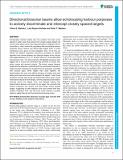Files in this item
Directional biosonar beams allow echolocating harbour porpoises to actively discriminate and intercept closely spaced targets
Item metadata
| dc.contributor.author | Malinka, Chloe Elizabeth | |
| dc.contributor.author | Rojano-Donante, Laia | |
| dc.contributor.author | Madsen, Peter T | |
| dc.date.accessioned | 2022-08-12T23:34:30Z | |
| dc.date.available | 2022-08-12T23:34:30Z | |
| dc.date.issued | 2021-08-13 | |
| dc.identifier | 279456298 | |
| dc.identifier | aba2361b-d63b-452f-8da5-87b98a8fe0c4 | |
| dc.identifier | 85113286700 | |
| dc.identifier.citation | Malinka , C E , Rojano-Donante , L & Madsen , P T 2021 , ' Directional biosonar beams allow echolocating harbour porpoises to actively discriminate and intercept closely spaced targets ' , Journal of Experimental Biology , vol. 224 , no. 16 , jeb242779 . https://doi.org/10.1242/jeb.242779 | en |
| dc.identifier.issn | 0022-0949 | |
| dc.identifier.uri | https://hdl.handle.net/10023/25845 | |
| dc.description | PhD funding was provided by Danmarks Grundforskningsfond (Danish National Research Council) grants to P.T.M. (27125). This, along with Office of Naval Research Global (ONR) awards N00014-18-1-2062 and N00014-20-1-2709, covered research time at Fjord & Bælt. | en |
| dc.description.abstract | Echolocating toothed whales face the problem that high sound speeds in water mean that echoes from closely spaced targets will arrive at time delays within their reported auditory integration time of some 264 µs. Here, we test the hypothesis that echolocating harbour porpoises cannot resolve and discriminate targets within a clutter interference zone given by their integration time. To do this, we trained two harbour porpoises (Phocoena phocoena) to actively approach and choose between two spherical targets at four varying inter-target distances (13.5, 27, 56 and 108 cm) in a two-alternative forced-choice task. The free-swimming, blindfolded porpoises were tagged with a sound and movement tag (DTAG4) to record their echoic scene and acoustic outputs. The known ranges between targets and the porpoise, combined with the sound levels received on target-mounted hydrophones revealed how the porpoises controlled their acoustic gaze. When targets were close together, the discrimination task was more difficult because of smaller echo time delays and lower echo level ratios between the targets. Under these conditions, buzzes were longer and started from farther away, source levels were reduced at short ranges, and the porpoises clicked faster, scanned across the targets more, and delayed making their discrimination decision until closer to the target. We conclude that harbour porpoises can resolve and discriminate closely spaced targets, suggesting a clutter rejection zone much shorter than their auditory integration time, and that such clutter rejection is greatly aided by spatial filtering with their directional biosonar beam. | |
| dc.format.extent | 15 | |
| dc.format.extent | 9620193 | |
| dc.language.iso | eng | |
| dc.relation.ispartof | Journal of Experimental Biology | en |
| dc.subject | Echolocation | en |
| dc.subject | Biosonar | en |
| dc.subject | Acoustic gaze | en |
| dc.subject | Acoustic field of view | en |
| dc.subject | Echo stream | en |
| dc.subject | Auditory scene analysis | en |
| dc.subject | GC Oceanography | en |
| dc.subject | QH301 Biology | en |
| dc.subject | DAS | en |
| dc.subject | NIS | en |
| dc.subject.lcc | GC | en |
| dc.subject.lcc | QH301 | en |
| dc.title | Directional biosonar beams allow echolocating harbour porpoises to actively discriminate and intercept closely spaced targets | en |
| dc.type | Journal article | en |
| dc.contributor.institution | University of St Andrews. School of Biology | en |
| dc.identifier.doi | https://doi.org/10.1242/jeb.242779 | |
| dc.description.status | Peer reviewed | en |
| dc.date.embargoedUntil | 2022-08-13 |
This item appears in the following Collection(s)
Items in the St Andrews Research Repository are protected by copyright, with all rights reserved, unless otherwise indicated.

